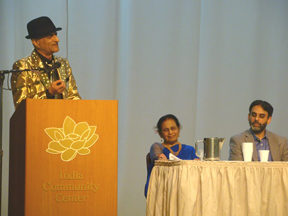
MILPITAS, CA: Every language has its own colorful and unique history. While few (besides the experts) can explain how a particular linguistic pattern emerged or how it caught widespread imagination with a high degree of accuracy, we can attribute its wide following to the work of masters.
South-Asia is home to many languages and each has a great deal of pride associated with it and can boast about many famous icons. Urdu is one such language and together with its sister language Hindi (and it’s possible many other cousins) has not defined geography or even ethnicity.
It came to be in northern India and is spoken or understood by a now worldwide Diaspora from its area of origin or widespread use in India and Pakistan plus small pockets in Bangladesh. And if one approaches almost anyone associated with this language the iconic pen-name Ghalib stands out and is bound to be revered.
An afternoon program aptly promoted as “Dabistan-e-Ghalib” was held at the ICC facility in Milpitas, California recently to the delight of the approximately 300 people present. For those who did not catch the “Dabistan” (School) part of the title, the name Ghalib was attraction enough.
And one could not be certain about the direction that this literary afternoon would take because Ghalib is probably the most well-known poet that the Urdu language has produced to date.
And the verses that he wrote over 150 years ago have gained so much traction over time that millions know them by heart today and recite them often. Baazi-cha-aie-Atfal Hai Dunia Mere Aage is one such poetic work which is often recited whole or segments remains embedded in our consciousness.
Few would have thought then that an Urdu poet who passed on from this world on February 15, 1869 in Delhi would establish such a strong literary presence far beyond India that one day he would be appreciated as far away as Northern California, and that an engineering software company named Computers & Structures Inc. would be sponsoring the event!
The point of this long introduction was that although Ghalib’s students were (and still are) immensely talented and that while this event tried its best to focus on two of them namely Salik and Majrooh, it was difficult to concentrate on their work. In spite of the hard work by all the presenters during this segment of ICC Series “Yaad-e-Raftgan”, it was distractive at best to concentrate on any poetry of the Shaagirds while their Ustad’s (Ghalib’s) work was either interspersed within or concurrently presented by them.
Full credit goes to Mrs. Hamida Banu-Chopra, who arranged this scholarly meet and to Adnan Malik for the Sadaarat of this Mehfil. And all the presenters including Almas, Abhay, Ghazala, Aftab, Joydeep, Vanbha and Salman deserve a big round of applause along with Anil Chopra (with his wife’s permission) and last but not least Ashraf Habibullah for presenting the most illuminating (or even illuminated) version of Ghalib’s poetry that this scribe has ever heard or witnessed.
These continuing events put together by Mrs. Hamida Chopra held at the ICC have now gained regional attention as Urdu enthusiasts from as far away as Sacramento attended this gathering. The South-Asian community here in the Bay Area and beyond has been supportive of such literary activity as the Urdu Academy here has also been active for quite some time now, collectively mindful of the fact that the beauty of the Urdu language should be shared by all.
In conclusion here one can observe that it is easy to appreciate a Dia-lamp or a Mashal in the moonlight, but that same effect is not pronounced or as impressive when a bright sun is shining! At this event we felt the warmth but not the light of the works of Majrooh and Salik, as Ghalib being the poetic sun stood out and remained overwhelming.
Ras H. Siddiqui






